SLVSAF0A August 2010 – May 2015 TLV61225
PRODUCTION DATA.
6 Specifications
6.1 Absolute Maximum Ratings
over operating free-air temperature range (unless otherwise noted)(1)| MIN | MAX | UNIT | ||
|---|---|---|---|---|
| Voltage(2) | VIN, L, VOUT, EN, FB | –0.3 | 7.5 | V |
| Temperature | Operating junction temperature, TJ | –40 | 150 | °C |
| Storage, Tstg | –65 | 150 | °C | |
(1) Stresses beyond those listed under Absolute Maximum Ratings may cause permanent damage to the device. These are stress ratings only, and functional operation of the device at these or any other conditions beyond those indicated under Recommended Operating Conditions is not implied. Exposure to absolute-maximum-rated conditions for extended periods may affect device reliability.
(2) All voltages are with respect to network ground terminal.
6.2 ESD Ratings
| VALUE | UNIT | |||
|---|---|---|---|---|
| V(ESD) | Electrostatic discharge | Human body model (HBM), per ANSI/ESDA/JEDEC JS-001(1) | 2000 | V |
| Charged-device model (CDM), per JEDEC specification JESD22-C101(2) | 1500 | |||
| Machine model (MM) | 200 | |||
(1) JEDEC document JEP155 states that 500-V HBM allows safe manufacturing with a standard ESD control process.
(2) JEDEC document JEP157 states that 250-V CDM allows safe manufacturing with a standard ESD control process.
6.3 Recommended Operating Conditions
| MIN | MAX | UNIT | ||
|---|---|---|---|---|
| VIN | Supply voltage at VIN | 0.7 | 3.3 | V |
| TA | Operating free air temperature | –40 | 85 | °C |
| TJ | Operating virtual junction temperature | –40 | 125 | °C |
6.4 Thermal Information
| THERMAL METRIC(1) | TLV61225 | UNIT | |
|---|---|---|---|
| DCK (SOT) | |||
| 6 PINS | |||
| RθJA | Junction-to-ambient thermal resistance | 231.9 | °C/W |
| RθJC(top) | Junction-to-case (top) thermal resistance | 55.8 | °C/W |
| RθJB | Junction-to-board thermal resistance | 77.3 | °C/W |
| ψJT | Junction-to-top characterization parameter | 0.7 | °C/W |
| ψJB | Junction-to-board characterization parameter | 76.4 | °C/W |
(1) For more information about traditional and new thermal metrics, see the Semiconductor and IC Package Thermal Metrics application report, SPRA953.
6.5 Electrical Characteristics
over recommended free-air temperature range and over recommended input voltage range (typical at an ambient temperature range of 25°C) (unless otherwise noted)| PARAMETER | TEST CONDITIONS | MIN | TYP | MAX | UNIT | ||
|---|---|---|---|---|---|---|---|
| DC-DC STAGE | |||||||
| VIN | Input voltage range | 0.7 | 3.3 | V | |||
| VIN | Maximum minimum input voltage for start-up | RLoad ≥ 150 Ω, TA = 25°C | 0.7 | V | |||
| VOUT | TLV61225 output voltage | VIN < VOUT | 3.13 | 3.3 | 3.43 | V | |
| ILH | Inductor current ripple | 200 | mA | ||||
| ISW | switch current limit | VOUT = 3.3 V, VIN = 1.2 V | 160 | 400 | mA | ||
| RDSon_HSD | Rectifying switch ON-resistance | VOUT = 3.3 V | 1000 | mΩ | |||
| RDSon_LSD | Main switch ON-resistance | VOUT = 3.3 V | 600 | mΩ | |||
| Line regulation | VIN < VOUT | 0.5% | |||||
| Load regulation | VIN < VOUT | 0.5% | |||||
| IQ | Quiescent current | VIN | IO = 0 mA, VEN = VIN = 1.2 V, VOUT = 3.3 V |
0.5 | 1 | μA | |
| VOUT | 5 | 10 | μA | ||||
| ISD | Shutdown current | VIN | VEN = 0 V, VIN = 1.2 V, VOUT ≥ VIN | 0.2 | 1 | μA | |
| ILKG_VOUT | Leakage current into VOUT | VEN = 0 V, VIN = 1.2 V, VOUT = 3.3 V | 1 | μA | |||
| ILKG_L | Leakage current into L | VEN = 0 V, VIN = 1.2 V, VL = 1.2 V, VOUT ≥ VIN | 0.01 | 0.7 | μA | ||
| IEN | EN input current | Clamped on GND or VIN (VIN < 1.5 V) | 0.005 | 0.1 | μA | ||
| CONTROL STAGE | |||||||
| VIL | Maximum EN input low voltage | VIN ≤ 1.5 V | 0.2 × VIN | V | |||
| VIH | Minimum EN input high voltage | VIN ≤ 1.5 V | 0.8 × VIN | V | |||
| VIL | Maximum EN input low voltage | VIN > 1.5 V | 0.4 | V | |||
| VIH | Minimum EN input high voltage | VIN > 1.5 V | 1.2 | V | |||
| VUVLO | Undervoltage lockout threshold for turnoff | VIN decreasing | 500 | mV | |||
| Undervoltage lockout hysteresis | 50 | mV | |||||
| Overvoltage protection threshold | 5.5 | 7.5 | V | ||||
| Overtemperature protection | 140 | °C | |||||
| Overtemperature hysteresis | 20 | °C | |||||
6.6 Dissipation Ratings
| PACKAGE | POWER RATING TA ≤ 25°C |
DERATING FACTOR ABOVE TA = 25°C |
|---|---|---|
| DCK | 444 mW | 4.44 mW/°C |
6.7 Typical Characteristics
Table 1. Table of Graphs
| FIGURE | ||
|---|---|---|
| Minimum of Maximum Output Current | vs Input Voltage | Figure 1 |
| Efficiency | vs Output Current, VIN = [1.2 V; 2.4 V; 3 V] | Figure 2 |
| vs Input Voltage, IOUT = [100 uA; 1 mA; 10 mA; 50 mA] | Figure 3 | |
| Input Current | vs Input Voltage at No Output Load, Device Enabled | Figure 4 |
| Output Voltage | vs Output Current, VIN = [1.2 V; 2.4 V] | Figure 5 |
| vs Input Voltage, Device Disabled, RLOAD = [1 kΩ; 10 kΩ] | Figure 6 |
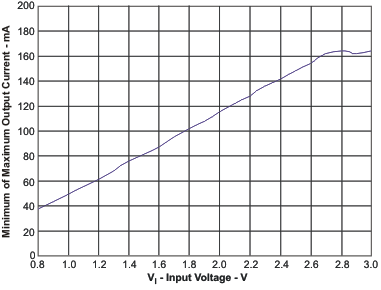 Figure 1. Minimum of Maximum Output Current vs Input Voltage
Figure 1. Minimum of Maximum Output Current vs Input Voltage
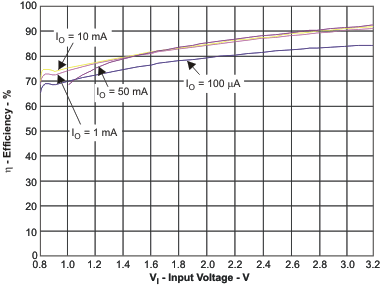 Figure 3. Efficiency vs Input Voltage
Figure 3. Efficiency vs Input Voltage
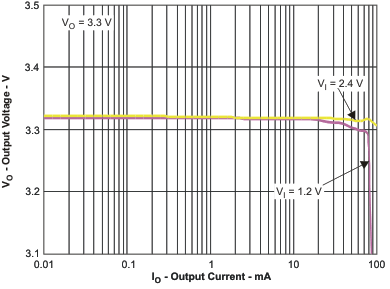 Figure 5. Output Voltage vs Output Current
Figure 5. Output Voltage vs Output Current
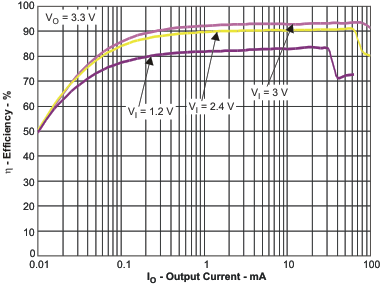 Figure 2. Efficiency vs Output Current
Figure 2. Efficiency vs Output Current
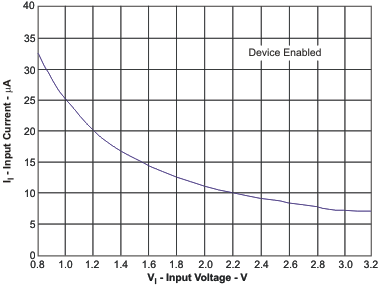 Figure 4. No Load Application Input Current vs Input Voltage
Figure 4. No Load Application Input Current vs Input Voltage
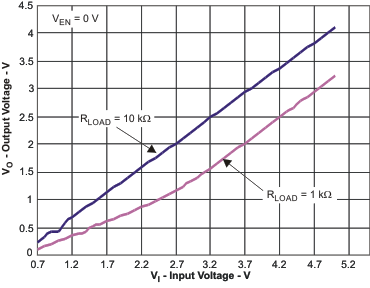 Figure 6. Output Voltage vs Input Voltage, Device Disabled
Figure 6. Output Voltage vs Input Voltage, Device Disabled